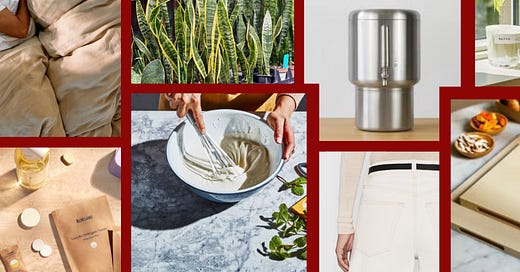Happy Friday, readers — I hope this finds you safe and well. It’s been quite the week (+) here in LA and I’ve honestly struggled to find words. It feels weird to go back to business as usual, but I’m committed to doing this work while continuing to support my friends and community that have been deeply affected by these horrific fires. Sending an extra big hug to everyone today. xx
Air quality is top of mind for me right now. With the fires in LA still not fully contained and a massive clean up of toxic debris ahead, so many in my community are laser focused on figuring out how to ensure clean air for themselves and their families. On my mom groups (I love mom groups, btw), we’re all becoming bonafide AQI experts—semi-fluent in particles sizes, like PM2.5 and PM10, volatile organic compounds (VOCs) not measured in standard AQIs, when to mask, when not to mask, what to do with our kids. We’re being told that this is something we may have to deal with long after the fires have been put out.
This post is about indoor air quality, but if you’re looking for information and guidance about outdoor air quality, read this post from my friend (a great Substack follow, too).
Whether you’re in LA or not, clean air is not something to be taken for granted. And sometimes the air inside your home can actually be worse than the air outside your home. Believe it or not, I was thinking about this post before devastating current events made me obsessed with air particles. So, here are 10 ways that you can improve your indoor air quality and create a safer space for you and your loved ones:
1. Shoes off at the door.
We step on a lot of s*** outside—gasoline, pesticides, dirt, debris, actual s***, and in the case of some of us in Los Angeles: toxic ash. A no shoe policy will help prevent these contaminants from entering your home. I’m admittedly not as great at this as I should be, but I’m working on it.
2. Dust and vacuum regularly.
If you’re concerned about wildfire smoke in your house, wet mop on hard surfaces so those particles don’t get into the air. Otherwise, a vacuum with a HEPA filter can capture a lot of particles in the air that reduce the air quality—like this one.
3. Declutter.
The more things you have in the house, the more opportunities for dirt and dust to collect. Organize and declutter regularly.
4. Invest in an air purifier.
There are many options at different price points. I have a Molekule Pro which covers 1000 square feet and I’m considering getting minis (coverage of 250 square feet) for my children’s rooms. They’re on sale via goop, too. This is also your reminder to change your HVAC filter.
5. Drink clean water.
Forever chemicals, microplastics, toxins and other contaminants are often found in the water we drink. Access to good quality filtered water is really important. I recently bought a Rorra countertop filter and I love it. I use it not just for drinking water, but for coffee, making rice, steaming vegetables, and more. For a Brita replacement, try Aarke’s water purifier.
6. Limit plastic.
If you’re a longtime subscriber, you know I’ve been on a journey to de-plastic my home. I’m working on an updated piece about plastic swaps (stay tuned), but this is a good time to take a look at your kitchen, personal care products, storage containers, and kids stuff. A few of my kitchen favorites in the meantime: rubber cutting boards, glass Tupperware, plastic-free cooking tools (discount code: MIAMATERIAL), bamboo colander, kids plates.
7. Avoid synthetic fragrances.
Many synthetic fragrances found in perfume, candles, personal care products, cleaning supplies, air fresheners, etc. contain (VOCs) like formaldehyde and phthalates. These can cause asthma, skin or eye irritations, headaches, and hormone disruptions. Instead, use products scented with essential oils. I really like Nette candles, VYRAO perfume, and Vitruvi aromatherapy diffusers.
8. Use natural cleaning products.
I wrote about this many Fridays ago, but here is the post with all my favorite products and resources in case you missed it.
9. Get some house plants.
Indoor plants can absorb pollutants, including VOCs like formaldehyde, create oxygen, and humidify spaces. My favorites are the snake plants, spider plants, English ivy, and peace lily, but there is a whole list of plants that can help purify your house.
10. Purchase linens and clothing with natural fibers.
Try to buy natural over synthetic fabrics for your linens, clothing, etc., and wash everything before you use it to remove chemical finishes. For linens I love Ettitude (completely nontoxic) and Parachute. Some clothing brands that use natural fibers include MATE the Label, Frame denim (look for the sustainable mark for regenerative organic cotton and use my discount code: MIA15), and Dôen (currently having a big sale). For babies and kids, Gap actually has a great collection of clothing made with natural fibers.
Sending love and clean air wishes to all of you.
xx Mia







Great tips, thank you. I love using plants to purify the air
PSA for those buying new air purifiers!!
My mom recently saw an Instagram reel about how many air purifiers have the inside filter wrapped in plastic and people don’t even realize it. They simply open the box, take out the air purifier and plug it in. So she had us check ours and sure enough we had been those people too 🤪! We bought them about three years ago and have used them sporadically. I always thought they were a little louder than I had anticipated and now I realize it was because of the plastic wrapped around the filter.